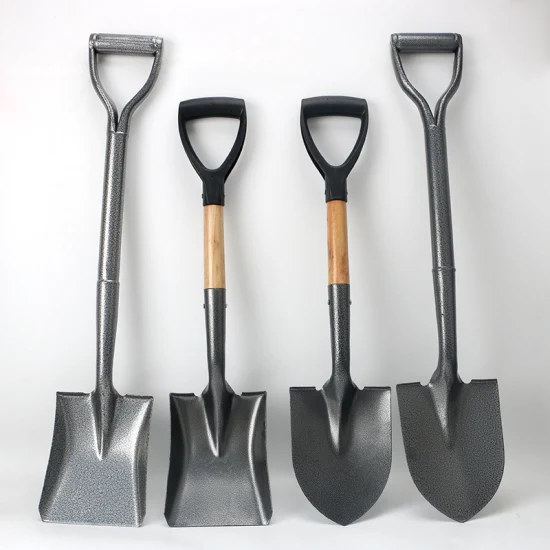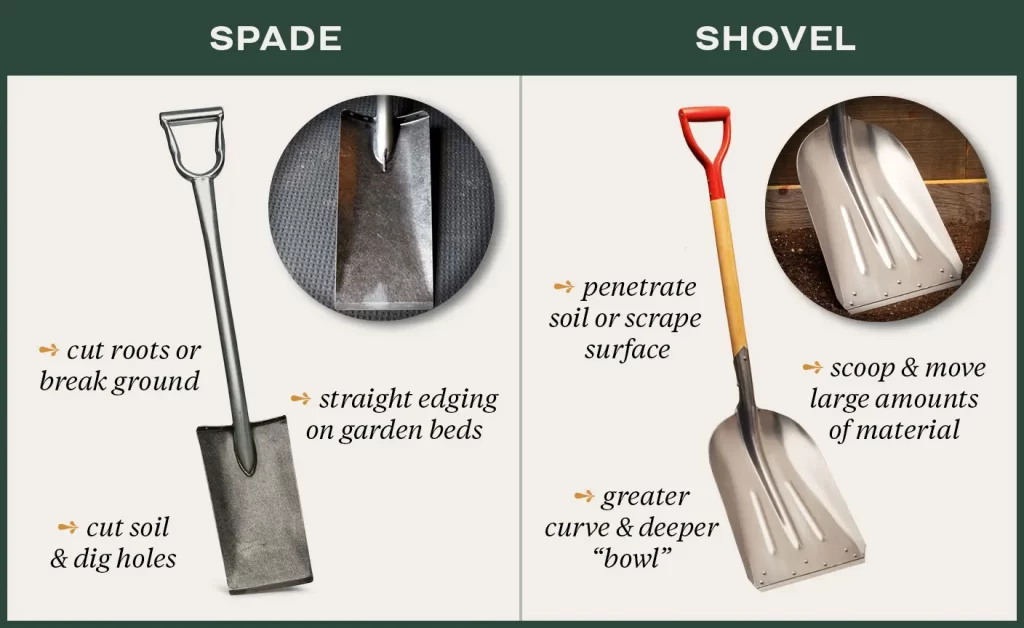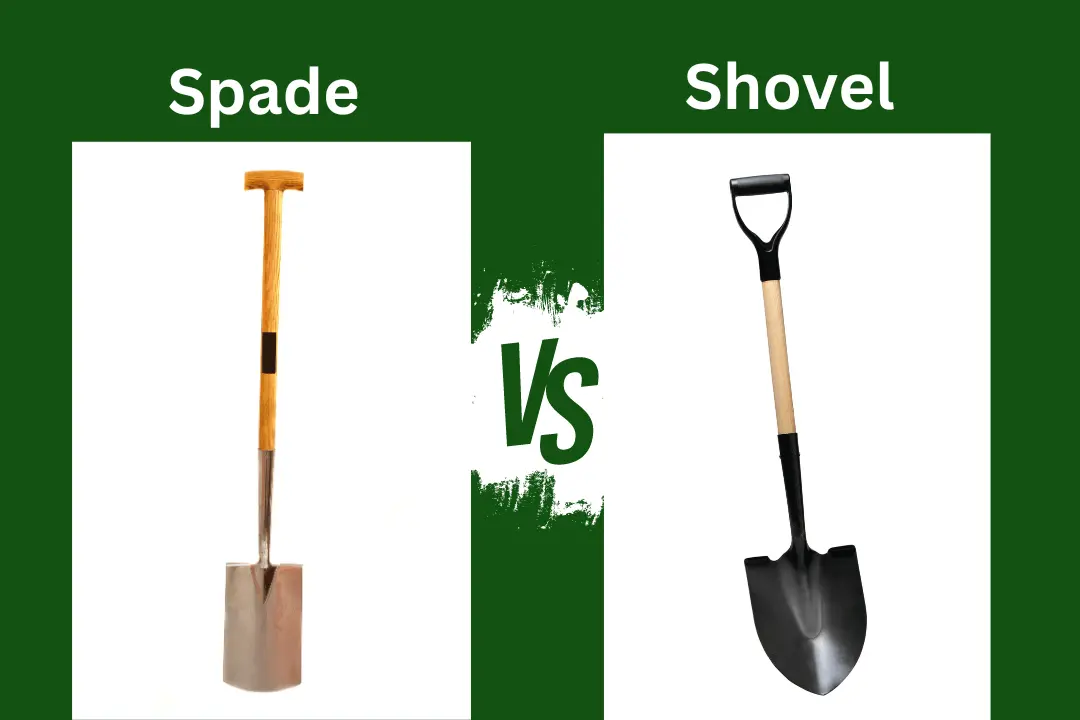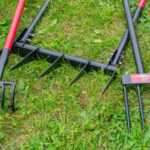Shovels and spades are essential hand tools used for digging, moving, and manipulating various materials like soil, gravel, sand, and snow. These simple yet versatile tools have been indispensable in human endeavors for centuries, playing crucial roles in agriculture, construction, landscaping, and even survival.
At their core, shovels and spades consist of a sturdy handle attached to a broad, curved blade or scoop. This design allows users to efficiently dig into the ground, scoop up materials, and transfer them from one location to another. While they may seem similar, shovels and spades have distinct characteristics that make them better suited for specific tasks.
The history of shovels and spades can be traced back to ancient civilizations, where early versions were crafted from materials like wood, stone, and animal bones. As humans transitioned from hunter-gatherers to settled agricultural communities, the need for tools to cultivate the land and construct shelters became paramount, driving the evolution of these essential implements.
Over time, improvements in metallurgy and manufacturing processes led to the development of more durable and efficient shovels and spades made from materials like iron, steel, and aluminum alloys. Today, these tools come in a wide variety of shapes, sizes, and designs, catering to diverse applications in gardening, construction, mining, and even military operations.
Types of Shovels
Shovels come in various shapes and designs to cater to different digging needs. The primary types of shovels include:
Round Point Shovels: These shovels feature a curved blade that tapers to a rounded point, making them ideal for digging in compact or rocky soil. The rounded tip allows for easier penetration and helps break up tough ground.
Square Point Shovels: With a flat, square-shaped blade, these shovels are excellent for edging, cutting through sod, and creating clean, defined edges in landscaping projects. They are also useful for scooping and moving loose materials like gravel or sand.
Flat Shovels: Also known as transfer shovels, these have a wide, flat blade designed for moving and spreading loose materials like soil, mulch, or gravel. They are commonly used in landscaping and gardening tasks.
Trenching/Ditching Shovels: These shovels have a narrow, elongated blade that tapers to a semi-pointed tip, making them perfect for digging deep, narrow trenches or ditches for planting, drainage, or utility work.
Snow Shovels: Designed specifically for snow removal, these shovels typically have a curved or ergonomic shaft and a large, broad blade to efficiently scoop and push snow. Some snow shovels also feature a metal wear strip along the blade’s edge for added durability.
Specialty Shovels: There are various specialized shovels tailored for specific tasks, such as drain spades for clearing clogged drains, root shovels for digging around roots, and nursery spades for transplanting and dividing plants.
Each type of shovel is engineered to excel at certain digging tasks, whether it’s breaking through tough soil, creating precise edges, moving loose materials, or tackling specialized jobs. Choosing the right shovel for the job at hand can significantly improve efficiency and reduce physical strain.

Types of Spades
Spades are versatile gardening tools designed for digging and moving soil, with a flat, rectangular blade and a shorter, straighter handle than a shovel. Here are some common types of spades:
Garden Spades: Also known as digging spades, these are the most common type. They have a broad, flat blade with a slightly curved edge to facilitate digging and lifting soil. Garden spades are ideal for breaking up compacted soil, edging garden beds, and digging holes for planting.
Drain Spades: These spades have a narrow, semi-cylindrical blade designed for digging trenches and clearing drainage channels. The blade’s shape allows for easy removal of soil from narrow spaces, making them useful for installing or maintaining drainage systems.
Edging Spades: With a flat, half-moon-shaped blade, edging spades are perfect for creating clean, defined edges along garden beds, lawns, and pathways. The sharp, curved blade slices through soil and roots, maintaining a tidy border.
Shoveling Spades: Sometimes called scooping spades, these have a deep, curved blade similar to a shovel but with a shorter, straighter handle. They are designed for scooping and moving loose materials like soil, gravel, or mulch, making them versatile for gardening tasks like filling raised beds or spreading materials.
Materials and Construction
Shovels and spades are constructed from a variety of materials, with the choice depending on the intended use and desired characteristics such as durability, weight, and cost. The two main components are the handle and the blade or scoop.
Handles are typically made from wood, fiberglass, or metal. Wooden handles offer a classic, traditional look and feel, and are generally inexpensive. However, they can be prone to cracking, splintering, or rotting over time, especially with exposure to moisture. Fiberglass handles are lightweight yet strong and resistant to weathering, making them a popular choice for gardening tools. Metal handles, usually aluminum or steel, are extremely durable and long-lasting but can be heavier and less comfortable for extended use.
The blade or scoop is the business end of the tool, responsible for digging, scooping, and moving materials. Steel blades are the most common and offer excellent strength and edge retention, though they can rust if not properly cared for. Aluminum blades are lightweight and rust-resistant but may dent or bend more easily than steel. Plastic blades are found on some less expensive or specialized tools, offering a lightweight and rust-proof option, albeit with reduced durability compared to metal.
The materials used in shovels and spades are carefully chosen to strike the right balance between strength, weight, cost, and intended application, ensuring these essential tools can withstand the rigors of digging, scooping, and moving various materials.

Ergonomics and Safety
Proper ergonomics and safety are crucial when using shovels and spades to prevent strain, fatigue, and injury. The handle length, grip design, and overall weight of the tool play a significant role in reducing physical stress and promoting efficient digging.
Handle Length: The ideal handle length varies based on the user’s height and the intended task. Generally, a longer handle (around 48-60 inches) is recommended for taller individuals or tasks that require less bending, such as moving loose materials or snow removal. Shorter handles (around 28-36 inches) are better suited for shorter users or tasks that involve more digging and lifting, like gardening or trenching.
Grip Design: An ergonomic grip design can significantly reduce hand and wrist strain. Look for handles with a D-shaped or oval cross-section, as these shapes conform better to the natural grip of the hand. Additionally, some handles feature a cushioned or textured grip, which enhances comfort and control during extended use.
Weight: The weight of the shovel or spade should be balanced to minimize fatigue and strain on the back, shoulders, and arms. Lightweight materials like fiberglass or aluminum are often preferred for their strength-to-weight ratio. However, heavier tools may be necessary for certain tasks, such as breaking through compacted soil or moving heavy loads.
Injury Prevention: To avoid common injuries like back strain, herniated discs, or muscle tears, it’s essential to practice proper lifting and digging techniques. When lifting a load, bend at the knees and keep your back straight, engaging your core muscles for support. When digging, maintain a stable stance with your feet shoulder-width apart and avoid twisting or overreaching. Take frequent breaks and switch between pushing and pulling motions to distribute the workload evenly.
By considering ergonomics and safety factors, you can select the most appropriate shovel or spade for your needs and reduce the risk of injury, ensuring a more comfortable and efficient digging experience.
Digging Techniques
Proper digging techniques are essential for maximizing efficiency and minimizing strain when using shovels and spades. The first step is to adopt the correct stance. Stand with your feet shoulder-width apart, knees bent, and back straight. This low, balanced position provides stability and leverage.
When digging, it’s generally more effective to push the shovel or spade into the ground rather than pull. Pushing allows you to use your body weight and leg strength, reducing strain on your back and arms. Angle the blade into the soil, then drive forward with your legs, keeping your arms relatively straight.
Leverage is key for efficient digging. Position yourself closer to the blade for more leverage when breaking through tough soil or sod. For lifting and throwing, move toward the shaft end to increase your mechanical advantage. Use the shovel’s weight and your body’s momentum to your advantage.
When lifting a full shovel or spade, keep the load close to your body and lift with your legs, not your back. Avoid twisting motions that could strain your spine. For heavy or repetitive digging, take breaks to prevent fatigue and injury.
Landscaping and Gardening Uses
Shovels and spades are essential tools for any landscaping or gardening project. Their versatility allows them to handle a wide range of tasks, from planting and edging to moving soil and digging trenches.
Planting
When it comes to planting, shovels and spades are invaluable tools. They can be used to dig holes for trees, shrubs, and other plants, ensuring that the roots have enough space to spread and thrive. The curved blade of a spade is particularly useful for creating precise holes with clean edges, while the larger scoop of a shovel is better suited for digging larger holes or moving larger amounts of soil.
Edging
Edging is a crucial aspect of landscaping, as it helps to define the boundaries of garden beds, pathways, and lawns. Spades are the ideal tool for this task, as their sharp, flat blades can create clean, straight lines in the soil. By pushing the spade vertically into the ground and running it along the desired edge, gardeners can create a neat and tidy separation between different areas of their landscape.
Soil Moving
Whether you’re preparing a new garden bed, leveling ground for a patio or deck, or simply redistributing soil in your yard, shovels and spades are the go-to tools. Their wide, curved blades are designed to scoop up and move large quantities of soil with ease. Shovels, in particular, are well-suited for this task, as their larger capacity allows you to move more soil with each scoop.
Trench Digging
Digging trenches is a common task in landscaping, whether it’s for installing drainage systems, laying pipes or cables, or creating raised garden beds. Spades are the ideal tool for this job, as their sharp, flat blades can cut through soil with precision. By digging a series of overlapping holes and removing the soil, gardeners can create clean, straight trenches of varying depths and widths.
With their versatility and durability, shovels and spades are essential tools for any landscaping or gardening project. Whether you’re planting, edging, moving soil, or digging trenches, these humble tools will help you create and maintain a beautiful outdoor space.
Construction and Excavation Uses
Shovels and spades are essential tools in construction and excavation projects, playing a crucial role in tasks such as digging foundations, grading surfaces, and creating drainage ditches. These sturdy implements are designed to handle the demanding work of moving and shaping large quantities of soil, gravel, and other materials.
When digging foundations, a sturdy round-point shovel or a trench shovel is often the tool of choice. These shovels feature a deep, curved blade that can penetrate and scoop out soil efficiently, allowing workers to dig deep and create precise foundation trenches or holes for footings. The round-point design also helps break through compact soil and small roots.
Grading a site is another common task that requires the use of shovels and spades. Grading involves leveling and shaping the ground to create a desired slope or contour. This process is essential for proper drainage, landscaping, and preparing the site for construction. Flat shovels, with their broad, flat blades, are ideal for grading, allowing workers to move and spread soil evenly across the surface.
Drainage ditches are crucial in preventing water accumulation and erosion on construction sites and landscaped areas. Trench shovels, with their long, narrow blades, are well-suited for digging these narrow, deep trenches. Their design allows for precise digging and the removal of soil from tight spaces, ensuring proper drainage and preventing potential water damage.
In addition to these specialized tasks, shovels and spades are versatile tools used for a variety of excavation and material handling tasks on construction sites. From breaking up compacted soil to moving gravel, sand, or debris, these tools are essential for efficient and productive work on any construction or excavation project.
Snow Removal
Shovels and spades are essential tools for snow removal during the winter months. While regular shovels can be used for light snowfall, specialized snow shovels are designed to make the task easier and more efficient, especially when dealing with heavy, wet snow or compacted snow and ice.
Snow shovels typically feature a curved or angled blade made of lightweight yet durable materials like plastic or aluminum. The curved design helps to scoop and lift the snow more effectively, reducing strain on the back and arms. Many snow shovels also have a ergonomically designed handle with a D-grip or bent shaft to provide better leverage and reduce the risk of injury.
When shoveling snow, it’s important to consider the type of snow you’re dealing with and adjust your technique accordingly. For light, fluffy snow, a wider shovel blade can be used to push and scoop larger amounts at once. However, for heavy, wet snow or compacted snow and ice, a narrower blade with a more angled design can help break through the dense layers more effectively.
For wet, heavy snow, it’s best to shovel in smaller sections and avoid lifting too much weight at once to prevent strain or injury. Applying a gentle rocking motion with the shovel can help break up the snow before lifting. Additionally, using a shovel with a metal edge or a separate ice chopper can assist in breaking through icy layers.
When shoveling snow, it’s crucial to take frequent breaks, stay hydrated, and dress warmly in layers to prevent overexertion or exposure to the cold. Proper technique, such as bending at the knees and using your leg muscles to lift, can also help reduce the risk of back injuries.
Overall, having the right snow shovel and employing the appropriate techniques can make snow removal more efficient and safer, ensuring your walkways, driveways, and outdoor areas remain clear and accessible throughout the winter season.
Care, Maintenance and Storage
Proper care and maintenance are crucial for extending the lifespan of your shovels and spades. Neglecting these essential tools can lead to rust, dullness, and premature wear, making them less effective and potentially unsafe to use.
Cleaning
After each use, thoroughly clean your shovels and spades to remove any dirt, debris, or moisture that may cause corrosion or damage. Use a stiff-bristled brush or a wire brush to scrub off any caked-on mud or soil. Rinse with clean water and dry the tools completely before storing them.
Sharpening
Over time, the blades of shovels and spades can become dull, making digging more difficult and increasing the risk of injury. Sharpen the blades regularly using a file or a grinding stone. Apply even strokes along the blade’s edge, maintaining the original bevel angle. A sharp tool will cut through soil more efficiently and require less effort.
Preventing Rust
Rust is the nemesis of metal tools, and shovels and spades are no exception. To prevent rust, always ensure that your tools are completely dry before storing them. You can also apply a thin layer of oil or rust-preventive coating to the metal surfaces, especially after sharpening or cleaning. Avoid leaving your tools outside or in damp environments for extended periods.
Storage Tips
Proper storage is essential for preserving the condition of your shovels and spades. Store them in a dry, well-ventilated area, such as a shed or garage. Hang them on a wall or place them in a tool rack to prevent the blades from coming into contact with the ground or other surfaces, which can cause dulling or damage. If storing them for an extended period, consider applying a thicker layer of rust-preventive coating or wrapping them in oiled rags or plastic sheeting.
By following these care, maintenance, and storage tips, you can ensure that your shovels and spades remain in top condition, ready to tackle any digging task with ease and efficiency.



